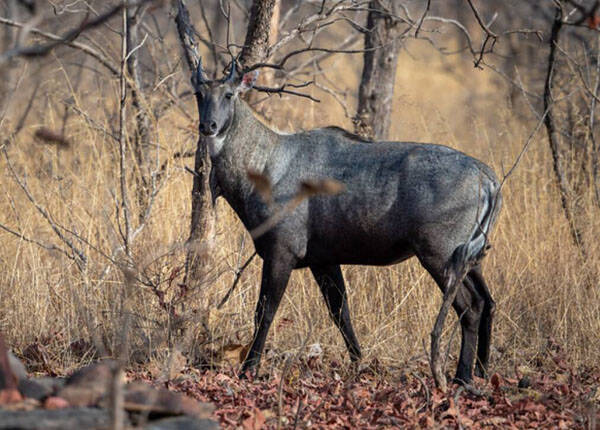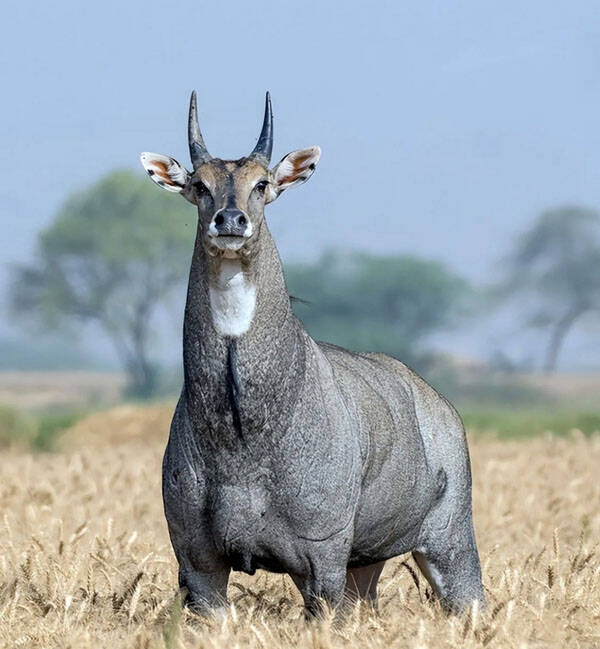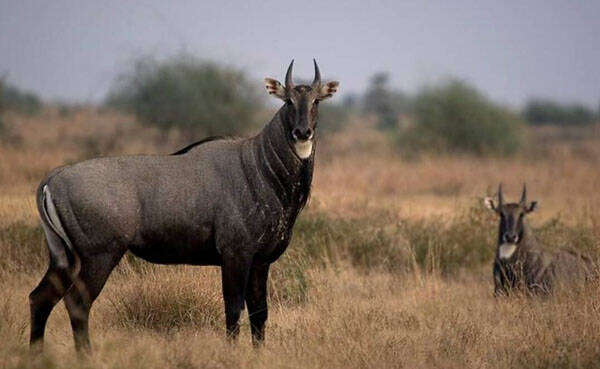Boselaphus tragocamelus
IUCN
LCBasic Information
Scientific classification
- name:Boselaphus tragocamelus
- Scientific Name:Boselaphus tragocamelus,blue antelope, blue scimitar-horned antelope, Indian antelope, blue bull
- Outline:Ungulata
- Family:Artiodactyla Bovidae Bluebuck
Vital signs
- length:180-200cm
- Weight:About 200kg
- lifetime:15-20years
Feature
They have a white "beard" below their throats, their front legs are usually longer, and their legs are often marked with white "socks"
Distribution and Habitat
Distributed in: India, Nepal and Pakistan
Extinct: Bangladesh
Introduced: Mexico and the United States.
Widely distributed in lowland areas of India and Nepal, extending to the border areas of Pakistan. Extinct in Bangladesh. The species has been introduced to the United States and Mexico.
Diverse habitats, living in arid areas, scrub, grassy plains, dry deciduous and broad-leaved forests, agricultural areas, preferring less scrub, scrubby trees and shrubby grasslands. But avoids dense forests and deserts.
In India, it lives in mixed groups with four-horned antelopes, Indian gazelles and blackbucks. In the Ramgarh National Park (Rajasthan, India), the bluebuck, like the four-horned antelope, prefers areas rich in Acacia and Asterix species.
Appearance
The Great Blue is one of the largest antelopes in Asia. They stand about 120-150 cm tall at the shoulder and are 180-200 cm long. They are sexually dimorphic; males are larger than females and have different skin colors. Females are one-fifth smaller than males; they have long limbs, with the forelimbs slightly longer than the hindlimbs; their hooves are narrow and pointed at the front; their shoulders are high and the front part of the body is higher and thicker than the back; their heads are long, with a slightly protruding forehead and a short neck; their bodies are strong and slope downward from the shoulders. The head is narrow and long, and only the males have horns, which are short and slightly pointed at the end and slightly tilted forward. The male horns are generally 20-25 cm long, black in color, sharp and curved. The Great Blue's horns lack the typical ring structure of other cattle horns. They have erected bristles on their necks. The females have shorter yellow-brown
Details
Bluebuck (scientific name: Boselaphus tragocamelus) is called Nilgai, Bluebuck in English, Nilgau in French, Nilgo in Spanish, Nilgau, Nilgauantilope in German, and has no subspecies.

The blue antelope is a diurnal animal, more active in the early morning and evening. It lives in groups, with most sexes living separately except during the breeding season. It usually forms small groups of about 10 animals, but larger groups of 20 to 70 have been found. It can be single-sex or mixed, and older males are sometimes solitary. Male antelopes are often solitary or in small groups, but in winter they gather in groups of 30-100. Female antelopes often live in groups or with their young to care for them.
Blue antelopes prefer to roost in the bushes to find food and shelter. They get most of their water from the grass and leaves they eat. They forage during the day and rest at night. Male antelopes will show the white hair under their necks or the stripes inside their ears as a warning when they are in danger. Both sexes will fight, including butting their necks or butting each other with their horns. Fighting can be brutal; despite the darker protective skin, cuts and even death can occur.

The bluebuck often roams the vast plains with the blackbuck. They can survive for a few days without water, but they also choose to live near water sources. They usually defecate in the same place. Deserts initially affected their distribution, but irrigation canals and wells have allowed them to survive in desert areas such as Jodhpur. This species has good vision, with eyesight and hearing equal to or better than that of white-tailed deer, but poor sense of smell. However, unlike gazelles, it can run up to 48 kilometers per hour when being chased, which is not fast, so it is easy for many animals to catch up and become food. They are usually quiet and silent, but when they are threatened and panic, they will make a roaring sound.
The blue antelope mainly feeds on grass, eating mesquite, oak, pea, croton, nightshade and various grasses. Sometimes other parts of plants are also eaten, such as flowers, seeds, fruits, leaves and buds.

Females and males of the blue antelope remain isolated for most of the year, except when breeding together. Breeding groups consist of a dominant male and a pair or more females. Mating usually occurs from December to March of the following year, but breeding may continue for a year. The gestation period is 240-258 days, and the species usually gives birth to twins. Females can become pregnant at 18 months of age, but rarely mate before 3 years of age. Males are sexually mature by 21/2 years of age, but are not able to compete well with other males until 4 years of age.
The population of the Greater Bluebuck (2001) in India is estimated to be more than 100,000, with a density of 0.2-11.4/km² in India, depending on habitat conditions, predation, protection, and competition with livestock. The species is abundant in localized areas in agricultural areas of Haryana, Uttar Pradesh, Rajasthan, and Gujarat. No data are available for the species in Nepal. The population in Pakistan is small. Generally stable or increasing. Ranches of about 37,000 wild Greater Bluebuck are established in Texas, USA, and the population near the Texas-Mexico border is estimated to be about 30,000 (2011).
Listed in the IUCN Red List of Threatened Species in 2016 ver3.1 - Least Concern (LC).
Listed in the CITES Appendix III of the Washington Convention as a protected animal.
Listed in Appendix I, II and III of the Convention on International Trade in Endangered Species of Wild Fauna and Flora (CITES) 2019 edition Appendix III.
Protect wild animals and eliminate game.
Maintaining ecological balance is everyone's responsibility!








